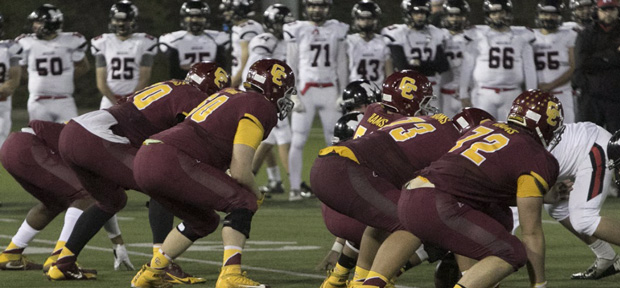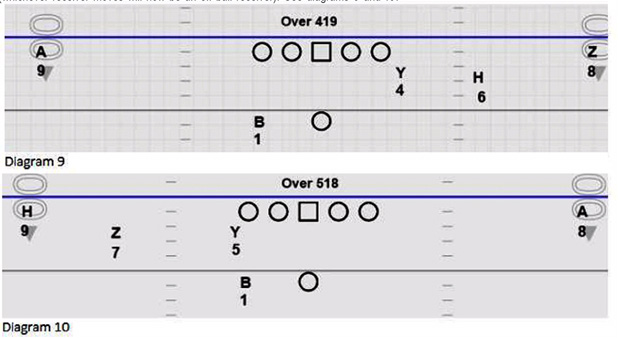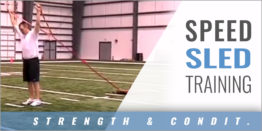| Formation Flexibility - Moving Your Best Athletes Where You Need Them |
| By: Steve Pyne - Head Coach • Portland Catholic High School
Provided by: American Football Monthly To set the stage, we run a multiple set, no huddle offense at Central Catholic and have been since 2003. We have evolved over the years with the intent of trying to go as fast as we could to gain an advantage over our opponent. Our evolution has led us to what we feel is a very efficient way to be multiple in formation and multiple in player alignment. Because of our desire to run up tempo and snap the ball within 7-10 seconds of it being put into play by the officials, we often struggled getting our best player(s) in multiple positions where we could utilize their varied skill sets from one play to the next. For example, moving our tailback from one side of the QB to the other or into the Pistol or moving our slot receiver to the backfield or aligning him on the outside of the formation would slow us down from play to play and we struggled to communicate this effectively to our players. As with most teams, there are 3-5 playmakers who bring varied skills to the field but they often get locked into one position and are limited in how those skills can be utilized within an offensive scheme. For example, our goal is to be able to move from a 3 x 2 empty formation to a tight end, 2-back formation with the same personnel on the field. In the spring of 2013 we moved to a numerical formation system that allowed us to move our playmakers where we wanted them and where they could create match up issues for our opponents. When we introduce the concept to our players we begin everything out of a 2 x 2 spread set (we refer to this as our ACE set). This allows our players to easily conceptualize where they need to line up, based on formation and play call (there are always alignment issues that need to be considered based on the concept of the play). For the purpose of this article we identify our left outside receiver as the H, our right outside receiver as Z, one slot receiver as Y, one slot receiver as B and our tailback as A. We have created 11 "rooms" for our players to occupy based on the numbers they are given. The call from the sideline is written on a dry erase board and also verbally communicated to the players. The players on the field will then echo the call to their teammates. The first number is assigned to the "Y", the second number is assigned to the "B" and the final number (or letter for Pistol) is assigned to the "A." With much greater ease we are able to get our two or three best skill players easily lined up on the same side of the formation or on opposite sides of the formation with little effort. We do not need to identify them on a particular series or individual play as the "H, Z, Y, B or A" and be limited as to where they align in the formation. This system allows for far greater flexibility to create match up advantages. We feel this stresses our opponent and makes it difficult for them to substitute based on our personnel. It also limits their defensive playbook as they have less time to adjust to our formations and difficulty matching our personnel with theirs at various spots on the field. As you can see by diagram 1, all the rooms are labeled 0,2,4,6 & 8 to the right and 1,3,5,7 & 9 to the left and P at 8 yards behind the center.
The Z and H receivers will always land in rooms 8 & 9 unless the "Y, B or A" are assigned to that room, which then bumps them down to the next open room. The H and Z are on the ball the majority of the time, but we can adjust that if necessary - this will be explained later in the article, in the "Over Rules". For example, if the formation call is 98P, the Y would line up in the 9, the B in the 8, and the A in the P. The H would then bump to the 7 and the Z would bump to the 6 (see Diagram 2).
We can easily get into a 2 back formation on the next play by calling 160 (Diagram 3).
With the same personnel we can then jump into an empty set with 769 (Diagram 4).
When we go into a tight end set (either a true tight end or a sixth offensive lineman) we give a tight left or tight right signal from the sideline. We designate that player at the "Y." When we give a tight left call the H is assigned the 1st number in the formation call and when we give a tight right call the Z is assigned the 1st number in the formation call (Diagrams 5 -8).
Within our Ace formation package we also have the ability to move the H and Z to the same side of the formation. We do this by making an "Over" signal from the sideline and if there is a "9" in the formation call the H will fill the first "open room" on the right side of the formation. If there is an "8" in the formation call the Z will fill the first "open room" on the left side of the formation (whichever receiver moves will now be an off ball receiver). (See diagrams 9 and 10).
Bunch left/right gets the Z, H, and Y to the bunch side and the B opposite the bunch. The A is the only player that gets a number. We can move the bunch tight or wide with a simple wide or tight signal from the sideline. (See diagrams 11 and 12).
The year prior to making the switch to how we call our formations currently the 2012 season) we averaged 50.6 plays per game and advanced to the state quarter-finals. The year we made the switch we averaged 56.7 plays per game and won the State Championship. In 2014 we averaged 56.2 plays per game and repeated as state champions. Through this system we were able to utilize our skill players and their different abilities in every different position on the field, this leading to greater production and results. Best of luck with your preparations for next season and beyond. Please do not hesitate to contact me if you have any questions (spyne@centralcatholichigh.org). |


















